The Ultimate Guide to the Kedarnath Trek: What You Need to Know
Kedarnath lies in the grand Himalayas, a special place where many come to pray or simply sit silently. Each year, throngs of hikers and sightseers come to witness its breathtaking views and ancient temples. While all of this might, in truth, be upon the great pathways of beauty, people often tend to forget the healthcare that is inextricably coaxed in their travel plans. The Kedarnath Trek is all about that fun with so much exploration of your fragile emotions. But did you even know that along the other side lay stiff and obstinate challenges? It’s not just about being thrilled; you should know the best time to go, get your gear together, and deal with altitude. Certain vital tips will help you to have a safe and astonishing adventure. Learn all that they entail just before you start off your trip!
Book here Chardham Yatra Packages
Kedarnath Trek Route & Distance
Kedarnath Trek Route & Distance
1. Starting Point: Gaurikund (Last motorable road).
2. Total Trek Distance: 16 km from Gaurikund to Kedarnath Temple.
3. Trek Duration: 6-8 hours, depending on fitness level and weather conditions.
4. Elevation Gain: 1,982 meters (Gaurikund) to 3,583 meters (Kedarnath Temple).
Kedarnath Trek Route & Key Points:
1. Gaurikund (0 km, 1,982m) – Trek starting point, hot springs, and lodging.
2. Jungle Chatti (4 km) – Rest stop with food stalls.
3. Bheembali (6 km) – Medical facilities and refreshments available.
4. Linchauli (11 km) – Beautiful landscapes; last major stop before Kedarnath.
5. Kedarnath Base Camp (14 km) – Tent accommodations, helipad nearby.
6. Kedarnath Temple (16 km, 3,583m) – Final destination, one of the Char Dham shrines.
Best Time to Visit Kedarnath Trek
From May to June and September to October, it is the best time to visit the Kedarnath Trip for favorable weather and accessibility to trekking paths. This period generally enjoys pleasant days with midsummer heat, ideal for outdoor activities. At night, temperatures become cool and comfortable. The snow by late spring usually melts, revealing breathtaking landscapes and rich greenery, allowing trekkers to fully immerse in nature’s beauty in the Himalayas. Also, opting for these months will steer clear of the heavy rains of the monsoon season and the chill side of winter to provide a safer and more enjoyable trekking experience.
How to Reach the Kedarnath Trek
By Air
The nearest airport to the Kedarnath Trip is Jolly Grant Airport, Dehradun, located about 250 km from Gaurikund. From the airport, travelers can hire taxis or take buses to reach Rishikesh, Haridwar, or Sonprayag. Helicopter services are available from Phata, Sirsi, and Guptkashi, providing a quicker alternative to trekking. Pre-booking is recommended, especially during peak pilgrimage season.
By Train
The closest railway stations to the Kedarnath Trip are Rishikesh (215 km), Haridwar (230 km), and Dehradun (250 km). From these stations, pilgrims and trekkers can take buses or taxis to Sonprayag, the nearest major stop before Gaurikund. Since there is no direct railway connection to Kedarnath, a combination of train and road travel is required. It’s advisable to book train tickets in advance, especially during the Char Dham Yatra season.
By Road
The Kedarnath Trip starts from Gaurikund, which is well-connected by road from major cities like Haridwar, Rishikesh, and Dehradun. Buses and taxis run regularly up to Sonprayag, from where shared jeeps operate to Gaurikund (5 km). The roads pass through scenic landscapes but can be affected by landslides during the monsoon season. Pilgrims should check road conditions before traveling and start early to avoid traffic congestion.
Top Destinations to Visit in Kedarnath
1. Kedarnath Temple
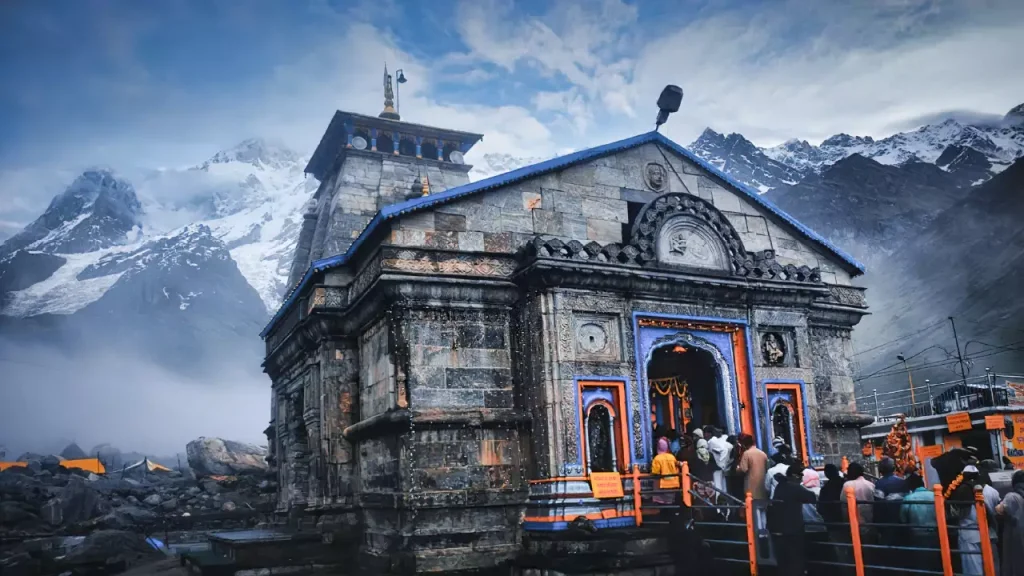
The Kedarnath Temple is the most sacred pilgrimage site dedicated to Lord Shiva and one of the 12 Jyotirlingas. Nestled in the Garhwal Himalayas at 3,583 meters, it is a key part of the Char Dham Yatra. The temple, believed to be built by the Pandavas and revived by Adi Shankaracharya, exudes spiritual and historical significance. Surrounded by snow-capped peaks, it offers a divine atmosphere for pilgrims and trekkers alike.
2. Bhairavnath Temple
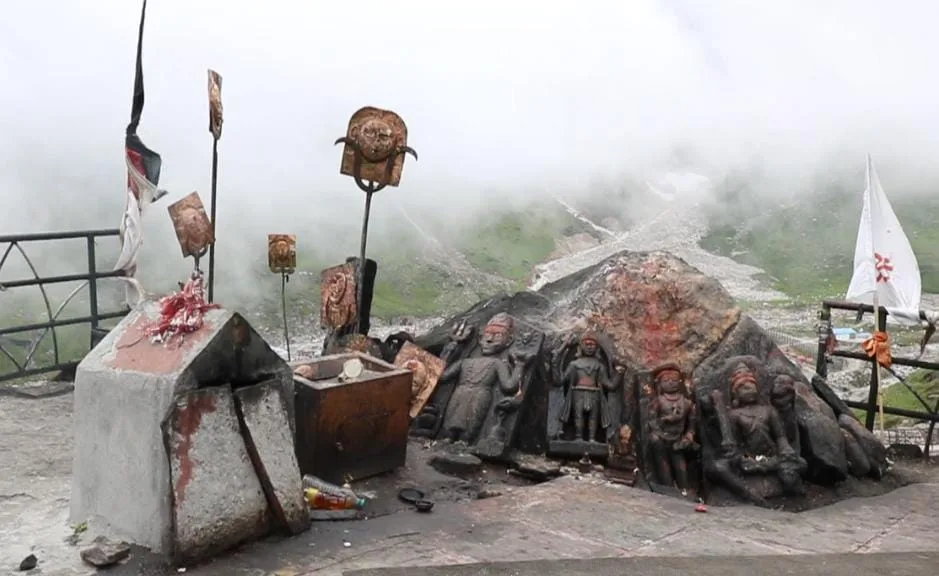
Located 500 meters uphill from the Kedarnath Temple, Bhairavnath Temple is dedicated to Bhairav, the fierce form of Lord Shiva. According to legend, Bhairavnath protects Kedarnath during the harsh winters when the main temple is closed. The trek to the temple provides panoramic views of the valley and snow-covered peaks. Pilgrims visit to seek blessings and admire the stunning natural beauty.
3. Adi Shankaracharya Samadhi
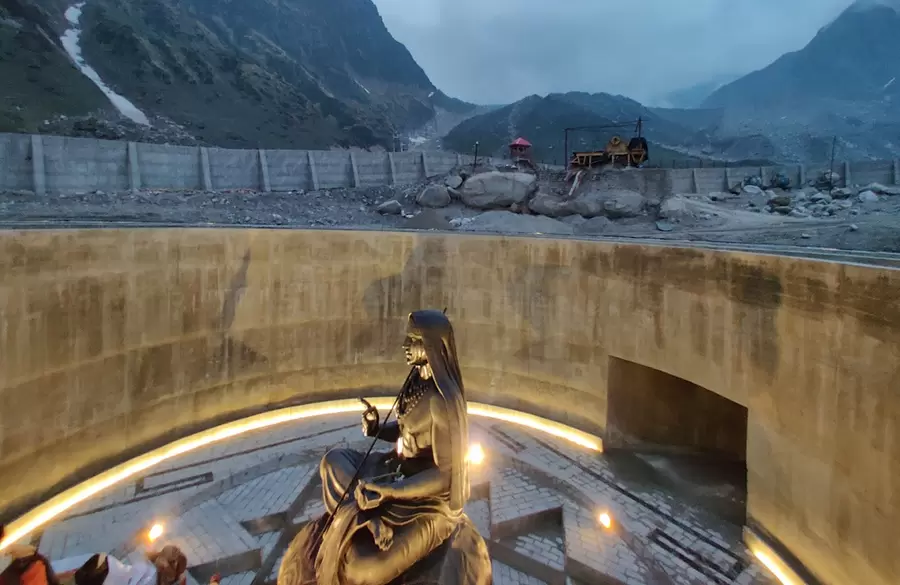
Situated right behind the Kedarnath Temple, this sacred spot marks the final resting place of Adi Shankaracharya, the great Hindu saint. He is credited with reviving the Char Dham pilgrimage and establishing the Advaita Vedanta philosophy. The samadhi was partially damaged in the 2013 Kedarnath floods but has since been restored. It remains a place of deep spiritual importance for devotees and scholars.
4. Vasuki Tal

An 8 km trek from Kedarnath, Vasuki Tal is a high-altitude glacial lake offering mesmerizing views of the Chaukhamba peaks. The lake is considered sacred, and legend says Lord Vishnu bathed here. The trek to Vasuki Tal is challenging yet rewarding, with breathtaking landscapes and rich biodiversity. It is an ideal destination for trekkers and nature lovers seeking peace and adventure.
5. Gandhi Sarovar (Chorabari Tal)
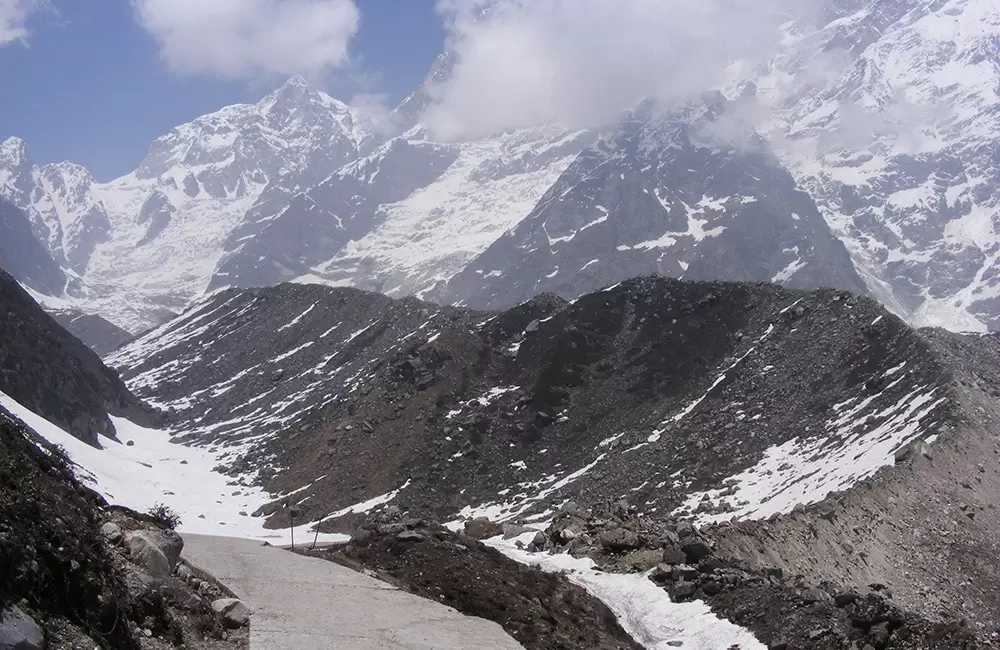
Located 3 km from Kedarnath, Gandhi Sarovar is a serene glacial lake near the Chorabari glacier. It is historically significant as Mahatma Gandhi’s ashes were immersed here, giving it the name Gandhi Sarovar. The short trek to the lake passes through rocky terrain and offers beautiful mountain views. The crystal-clear waters and peaceful surroundings make it a must-visit spot near Kedarnath.
6. Sonprayag

Sonprayag is a small yet significant spiritual town located on the way to Kedarnath. It is known for the holy confluence of the Mandakini and Basuki rivers, where pilgrims take a dip before proceeding further. The place is surrounded by lush greenery and towering mountains, offering a scenic backdrop. Sonprayag also serves as a major stop for travelers, with accommodation and transport facilities available.
7. Gaurikund
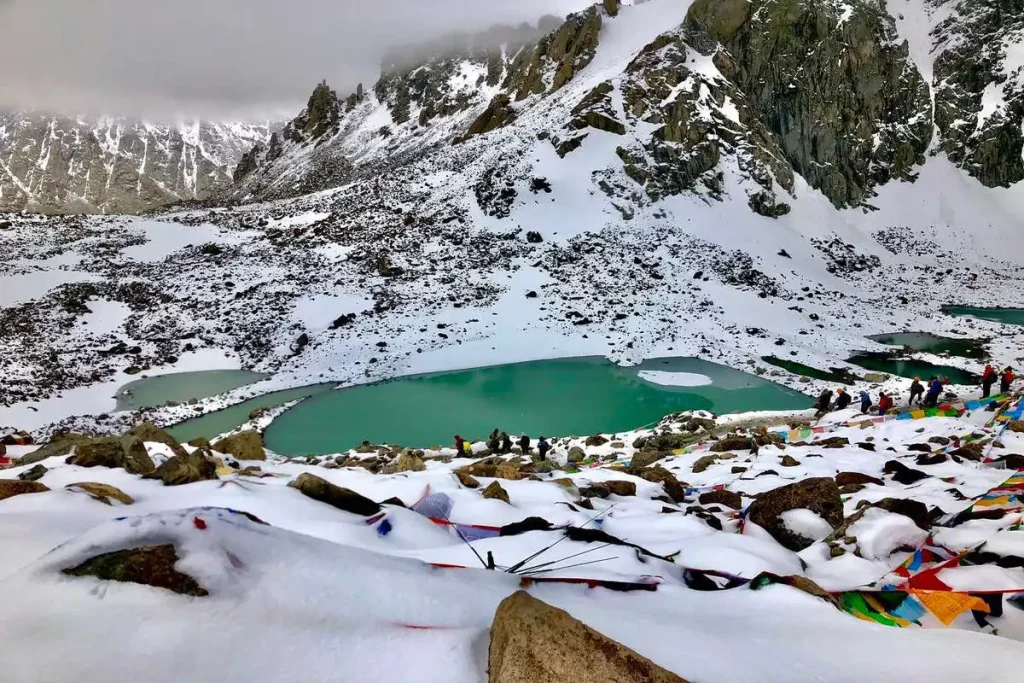
Gaurikund is the starting point of the Kedarnath Trip and holds religious significance in Hindu mythology. It is believed to be the place where Goddess Parvati meditated to win the love of Lord Shiva. The town is famous for its natural hot water springs, where pilgrims take a dip before starting the trek. Gaurikund also has a temple dedicated to Maa Gauri, attracting devotees year-round.
8. Triyuginarayan Temple
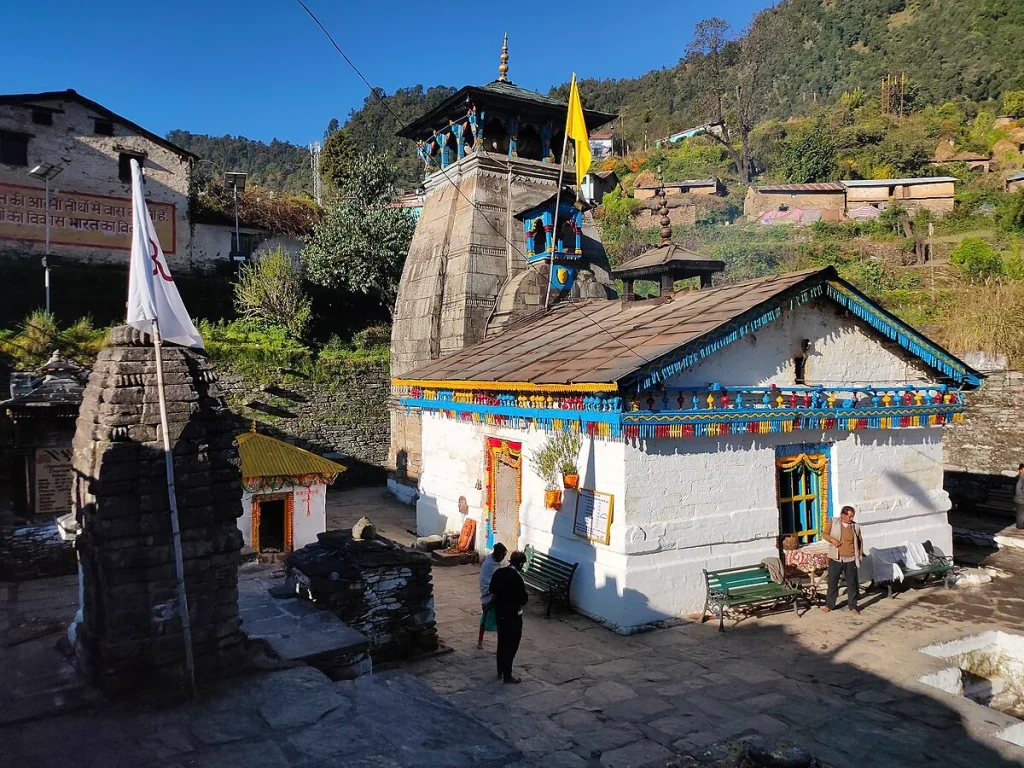
Located about 25 km from Sonprayag, Triyuginarayan Temple is a mythological site where Lord Shiva and Goddess Parvati were married. The temple features an eternal fire burning since their wedding, symbolizing their divine union. This site holds great religious significance and is a popular destination for couples seeking blessings. The temple’s location offers mesmerizing views of the snow-covered Himalayas and lush green surroundings.
Accommodation & Facilities on the Kedarnath Trek
1. Guesthouses & Hotels: Basic lodges, guesthouses, and budget hotels are available in Sonprayag, Gaurikund, and Linchauli. In peak season, pre-booking is recommended due to high pilgrim traffic.
2. GMVN (Garhwal Mandal Vikas Nigam) Huts: GMVN operates government lodges and tented accommodations near Kedarnath. These provide affordable stays with dormitories, rooms, and meal facilities for trekkers.
3. Tented Camps & Dharmshalas: Several private tented camps are set up at Linchauli and Kedarnath Base Camp. Dharmshalas near the temple offer low-cost stays, but facilities may be basic.
4. Food & Refreshments: Small eateries and stalls provide tea, Maggi, parathas, and snacks along the trekking route. Hot meals are available at GMVN rest houses and local dhabas near Kedarnath.
5. Medical & Emergency Services: Medical aid centers are present at Gaurikund, Linchauli, and Kedarnath Base Camp. Helicopter evacuation and emergency response teams are available in case of health issues.
6. Mobile Connectivity & Charging: Mobile networks are limited after Sonprayag, but BSNL and Jio provide partial coverage in Kedarnath. Charging facilities are available at guesthouses, but power cuts are frequent.
7. Toilets & Sanitation: Public toilets and bio-toilets are installed along the trek, especially at major rest points like Jungle Chatti and Bheembali. Most guesthouses have basic attached or shared toilets.
8. Porter & Mule Services: Porters and mules can be hired from Gaurikund to carry luggage or assist those unable to walk. Charges vary based on weight and distance, and rates are fixed by authorities.
Safety Tips & Precautions for the Kedarnath Trip
1. Acclimatize Properly: Since Kedarnath is at 3,583 meters, allow your body to adjust to the altitude. Spend a day at Gaurikund or Sonprayag before starting the trek to prevent altitude sickness.
2. Stay Hydrated: Drink plenty of water and electrolyte-rich fluids to avoid dehydration. Carry a reusable water bottle and use water purification tablets if refilling from natural sources.
3. Dress in Layers: Wear thermal inners, a fleece jacket, and a waterproof outer layer to protect against the cold. Always carry a rain poncho or windproof jacket for unpredictable weather.
4. Follow Trekking Guidelines: Stick to the designated trekking route and avoid shortcuts, as off-trail paths can be dangerous. Always follow government and local authority guidelines for a safe journey.
5. Carry a First Aid Kit: Pack essential medicines, band-aids, antiseptic cream, pain relievers, and altitude sickness tablets. A muscle spray or knee support can help reduce strain on steep trails.
6. Beware of Sudden Weather Changes: The Weather in Kedarnath can change rapidly, bringing heavy rains, snowfall, or landslides. Check the weather forecast before trekking and avoid traveling in extreme conditions.
7. Trek During Daylight Hours: Start trekking early in the morning to avoid nighttime risks. Limited visibility and cold temperatures make night trekking unsafe, so plan to reach your destination before sunset.
8. Use Proper Footwear & Gear: Wear sturdy trekking shoes with a good grip to prevent slipping on steep or wet trails. Carry a walking stick for support and headlamps for early morning or late evening travel.
Conclusion
The Kedarnath Trek is a travel odyssey dedicated to the endurance of adventure and the splendors of nature. It is the most perfect mix of spirituality and adventure. The Kedarnath Temple, standing tall in the mountains, fills the soul with divine energy, peace, and inspiration. This trek, either for a religious pilgrimage or for adventure, would leave an imprint that will last forever in life and will teach perseverance while being blessed with a once-in-a-lifetime experience, witnessing the raw grandeur of nature. If combined with preparation and a determined spirit, it becomes a life-changing pilgrimage, bringing memories for generations to come.
Here you can also check our Chardham Yatra Packages.
People also ask about the Kedarnath Trek
1. What is the total distance of the Kedarnath Trek?
The trek from Gaurikund to Kedarnath is approximately 16 km.
2. How long does it take to complete the Kedarnath Trek?
It usually takes 6 to 8 hours to trek one way, depending on your pace and fitness level.
3. What is the best time to visit Kedarnath?
The ideal time for the trek is from May to June and September to October, as the weather is pleasant and the route is accessible.
4. Is the Kedarnath Trek difficult?
The trek is moderate to difficult, with steep climbs and high-altitude challenges. Proper fitness preparation is recommended.
5. Can senior citizens or children do the Kedarnath Trip?
Yes, but it depends on their health. Pony, palki, and helicopter services are available for those unable to trek.
6. What should I carry for the Kedarnath Trek?
Essentials include warm clothing, trekking shoes, rain gear, water bottles, energy snacks, and a first-aid kit.
7. Are there accommodation options available in Kedarnath?
Yes, GMVN guesthouses, tents, and dharamshalas are available near the temple for overnight stays.
8. What are the transport options to reach Kedarnath?
You can travel by road to Gaurikund from Haridwar, Rishikesh, or Dehradun and then proceed on foot, by pony, or via helicopter.
9. Is mobile network connectivity available on the trek?
Network coverage is limited, but BSNL and Jio networks work in some areas.
10. Is prior registration required for the Kedarnath Yatra?
Yes, registration is mandatory, and it can be done online or at designated centers before starting the trek.
